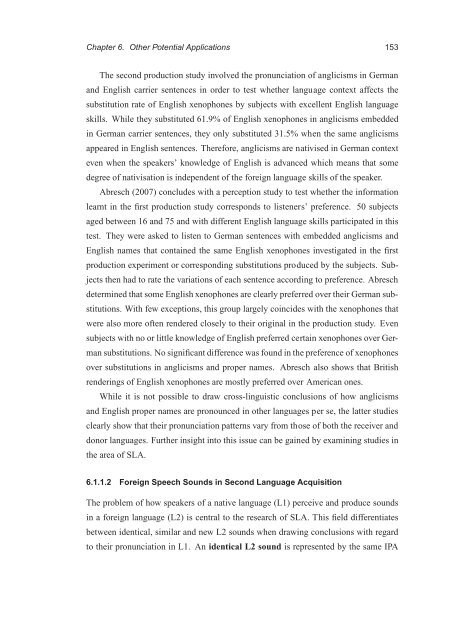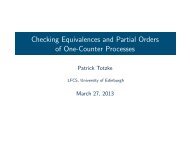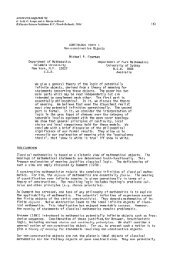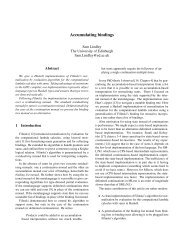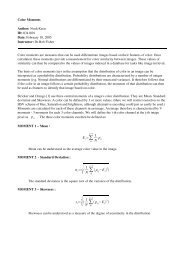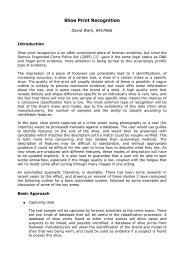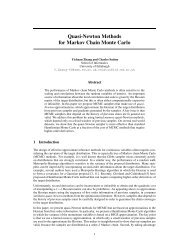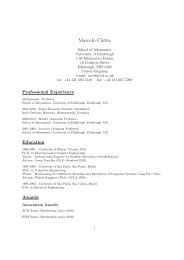PhD thesis - School of Informatics - University of Edinburgh
PhD thesis - School of Informatics - University of Edinburgh
PhD thesis - School of Informatics - University of Edinburgh
Create successful ePaper yourself
Turn your PDF publications into a flip-book with our unique Google optimized e-Paper software.
Chapter 6. Other Potential Applications 153<br />
The second production study involved the pronunciation <strong>of</strong> anglicisms in German<br />
and English carrier sentences in order to test whether language context affects the<br />
substitution rate <strong>of</strong> English xenophones by subjects with excellent English language<br />
skills. While they substituted 61.9% <strong>of</strong> English xenophones in anglicisms embedded<br />
in German carrier sentences, they only substituted 31.5% when the same anglicisms<br />
appeared in English sentences. Therefore, anglicisms are nativised in German context<br />
even when the speakers’ knowledge <strong>of</strong> English is advanced which means that some<br />
degree <strong>of</strong> nativisation is independent <strong>of</strong> the foreign language skills <strong>of</strong> the speaker.<br />
Abresch (2007) concludes with a perception study to test whether the information<br />
learnt in the first production study corresponds to listeners’ preference. 50 subjects<br />
aged between 16 and 75 and with different English language skills participated in this<br />
test. They were asked to listen to German sentences with embedded anglicisms and<br />
English names that contained the same English xenophones investigated in the first<br />
production experiment or corresponding substitutions produced by the subjects. Sub-<br />
jects then had to rate the variations <strong>of</strong> each sentence according to preference. Abresch<br />
determined that some English xenophones are clearly preferred over their German sub-<br />
stitutions. With few exceptions, this group largely coincides with the xenophones that<br />
were also more <strong>of</strong>ten rendered closely to their original in the production study. Even<br />
subjects with no or little knowledge <strong>of</strong> English preferred certain xenophones over Ger-<br />
man substitutions. No significant difference was found in the preference <strong>of</strong> xenophones<br />
over substitutions in anglicisms and proper names. Abresch also shows that British<br />
renderings <strong>of</strong> English xenophones are mostly preferred over American ones.<br />
While it is not possible to draw cross-linguistic conclusions <strong>of</strong> how anglicisms<br />
and English proper names are pronounced in other languages per se, the latter studies<br />
clearly show that their pronunciation patterns vary from those <strong>of</strong> both the receiver and<br />
donor languages. Further insight into this issue can be gained by examining studies in<br />
the area <strong>of</strong> SLA.<br />
6.1.1.2 Foreign Speech Sounds in Second Language Acquisition<br />
The problem <strong>of</strong> how speakers <strong>of</strong> a native language (L1) perceive and produce sounds<br />
in a foreign language (L2) is central to the research <strong>of</strong> SLA. This field differentiates<br />
between identical, similar and new L2 sounds when drawing conclusions with regard<br />
to their pronunciation in L1. An identical L2 sound is represented by the same IPA


